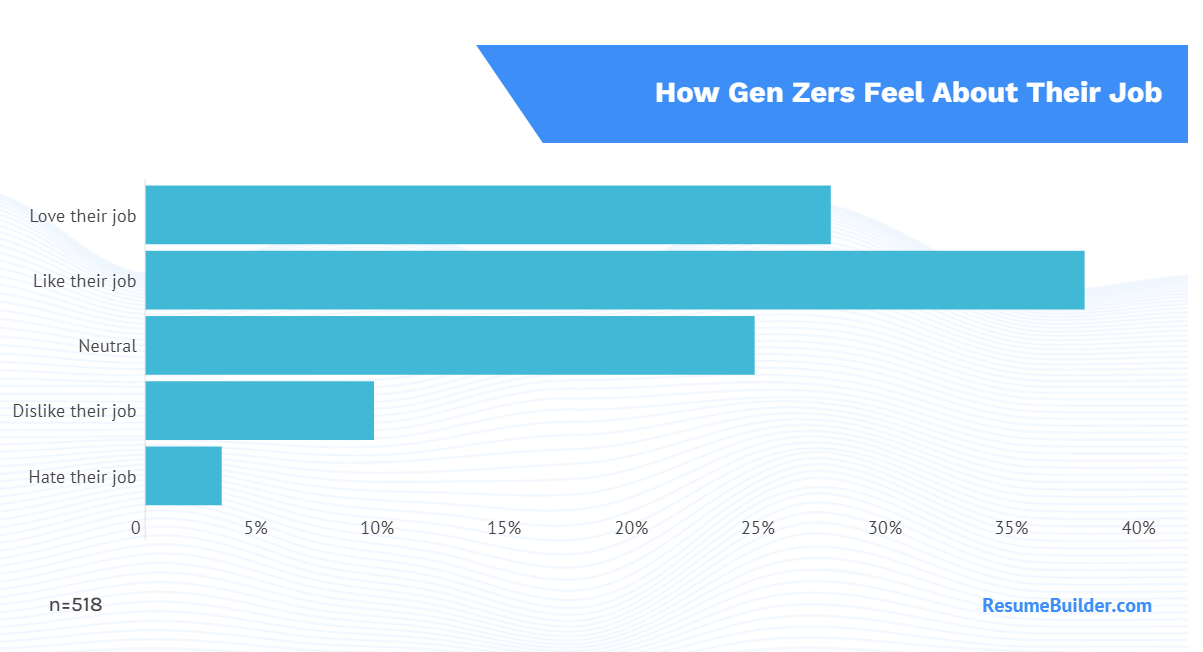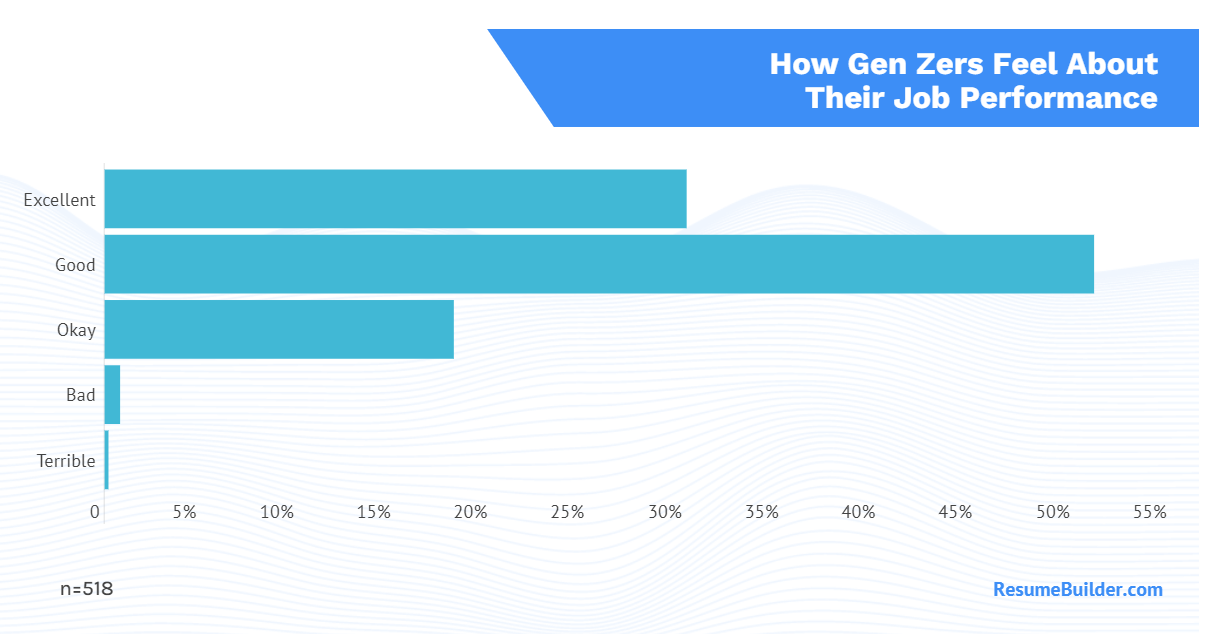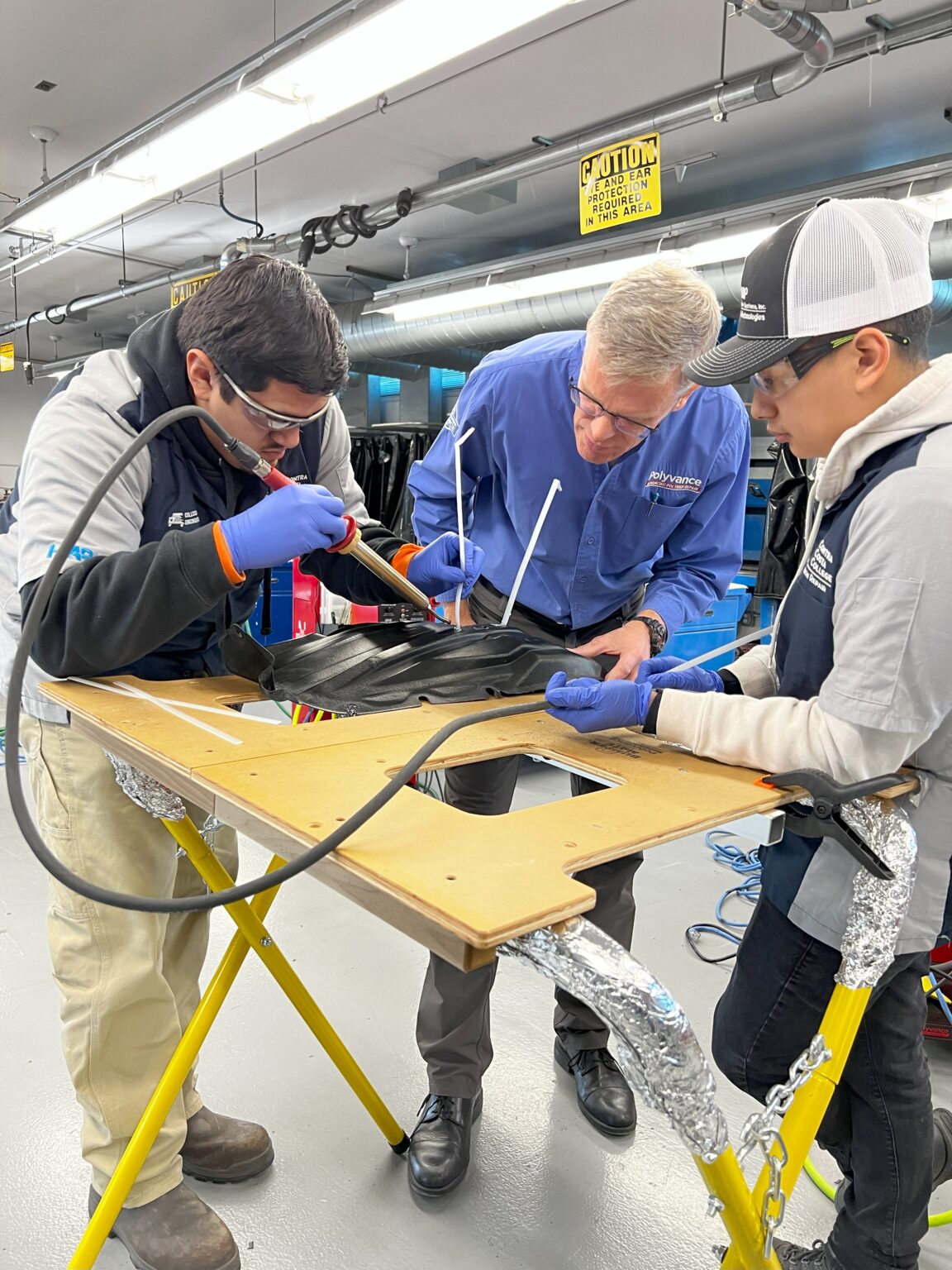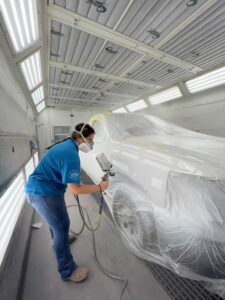
Survey finds Gen Z work ethic perception incorrect, trades education enrollment on the rise
By onBusiness Practices | Education
Despite the common societal perception that Gen Zers don’t like their jobs and lack a strong work ethic, a survey from ResumeBuilder.com found nearly a third of respondents love their jobs.
The survey results also provide insight into a sample of 518 Gen Zers’ perceptions, ages 18-27, on their performance, bosses, and co-workers. The survey was conducted in March.
In addition to the 27% who said they love their jobs, 37% said they like their job, and 24% said they’re neutral about their job. Nine percent said they dislike their job and 3% said they hate their job.
Among Gen Zers who dislike or hate their jobs, 45% said it’s because of poor work-life balance, 34% because of unsatisfactory work hours, and 36% due to a lack of passion for their job. According to Julia Toothacre, Resume Builder’s resume and career strategist, those findings are on par with most professionals; it’s expected that a portion of the workforce dislikes various aspects of their job and work in general.
“People early in their careers tend to be given this narrative of hating their jobs because they usually switch jobs more frequently,” said Toothacre, in a news release about the survey findings. “What many people fail to realize is that when you’re in your 20s, you’re figuring yourself out and trying different career options to see what you like most.
“Gen Z is much more self-aware than I’ve seen of other generations entering the workforce. They know what they want and don’t want in the workplace, and they align their values to their career. This wasn’t common in previous generations. It’s not everyone, but it’s enough that these results tell me that Gen Z likes the work they do because they have found alignment with it. The key to keeping Gen Z is providing them with opportunities for growth.”
Seventy-two percent of Gen Zers in the business or Science Technology Engineering and Mathematics (STEM) industries report liking or loving their jobs compared to 50% of those in customer service, retail, and service industries, according to the survey results. There’s also a correlation between income and job satisfaction — Gen Zers with higher incomes are more likely to report satisfaction at work than those with lower incomes, Resume Builder found.
“Money doesn’t buy happiness, but it buys comfort and time,” Toothacre said. “These results reinforce that if you pay people a living wage that supports not only their basic needs, but allows them to live their lives, they are likely going to be happier all around.”
Most of the Gen Zers surveyed said they feel positive about their jobs with 81% assessing their job performance as excellent or good.
Fifty-three percent expressed positive feelings about their boss followed by 34% feeling neutral, and 13% feeling negatively. Sixty percent of respondents said they love or like their co-workers. Thirty-one percent felt neutral and 9% said they dislike or hate their co-workers.
Gen Zers with higher incomes reported that they like their job more often than those with lower incomes:
-
- Income less than $40,000 (57% like or love their job);
- Income between $40,000 to $69,000 (55% like or love their job);
- Income between $70,000 to $99,999 (78% like or love their job); and
- Income $100,000 and up (80% like or love their job).
“Money doesn’t buy happiness, but it buys comfort and time,” said Toothacre.”These results reinforce that if you pay people a living wage that supports not only their basic needs, but allows them to live their lives, they are likely going to be happier all around.”
A recent Wall Street Journal article calls Gen Z the “toolbelt generation” by answering the call for needed skilled trade workers.
Many of America’s youngest workers are choosing to avoid college and choosing trades instead, according to the article.
“Rising pay and new technologies in fields from welding to machine tooling are giving trade professions a face-lift, helping them shed the image of being dirty, low-end work,” the article states. “Growing skepticism about the return on a college education, the cost of which has soared in recent decades, is adding to their shine.”
The number of students enrolled in vocational-focused community colleges increased 16% in 2023 to its highest level since the National Student Clearinghouse began tracking such data in 2018, according to the WSJ. “The ranks of students studying construction trades rose 23% during that time, while those in programs covering HVAC and vehicle maintenance and repair increased 7%.”
This sheds light on collision repair industry professionals citing competition with other trades as a contributor to the ongoing technician shortage.
One young worker the WSJ spoke to said he chose a career in welding, in part, because both of his parents’ jobs require all their time to be spent behind a computer, which didn’t appeal to him. A six-figure income by his fifth year as a welder also appealed to him.
“It feels good at the end of the day, I’m physically doing something and there’s a sense of completion,” said Tanner Burgess, according to the WSJ. The 20-year-old graduated from a nine-month welding program last fall.
In addition to the exodus away from college to the trades, the popularity of apprenticeships is on the rise, according to the WSJ. “In a survey of high school and college-age people by software company Jobber last year, 75% said they would be interested in vocational schools offering paid, on-the-job training… The majority of respondents Jobber surveyed said they thought blue-collar jobs offered better job security than white-collar ones, given the growth of AI.”
“I’ll be honest, it took me a little bit mentally to get on board,” Burgess’s mother, Lisa Hopkins, told the WSJ.
Hopkins studied drama and art history before obtaining a master’s in business administration and hasn’t had much exposure to the trades.
“He’s already thinking, ‘I want to buy my first house by the time I’m 24. I don’t have any debt, I’m off to the races,” she said, while explaining she’s happy he’s found a career he loves with good prospects.
The addition of updated equipment at schools that offer skilled trades programs has also helped change the grease monkey, “ne’er-do-wells and troublemakers” perception of the trades, according to a Wisconsin high school counselor the WSJ spoke to. This perception is something most collision repair businesses are all too familiar with as a detriment to technician recruitment.
A new study cited by the WSJ article and performed by labor analytics firm Burning Glass Institute and Strada Education Foundation shows that roughly half of college graduates end up in jobs where bachelor’s degrees aren’t needed, and many high-school graduates say they’re disinclined to take on college debt.
Some in Gen Z say they’re drawn to the skilled trades because of their entrepreneurial potential, according to the WSJ article. Colby Dell, 19, is attending trade school for automotive repair with plans to launch his own mobile detailing company, one he wants to eventually expand into custom body work.
“I always thought it was a hobby,” he told the WSJ about his love of cars. “Looking into these vocational schools, I realized it was a dream I could really pursue.”
Not only is there a shortage of collision, automotive, and diesel technicians there’s also a lack of women in those fields.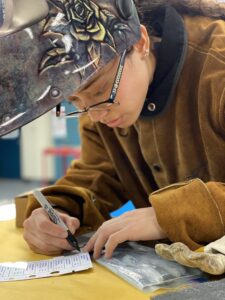
Rocky Mountain PBS recently spoke to a six-year automotive technician in Colorado, Jordan Delitz, who said she’s been the first female technician at every job she’s had.
“I’ve had a lot of challenges being talked down to, being gaslighted,” Delitz told the publication. “It’s like these men are talking to me like I’m their wife and not their co-worker and not treating me with the equal respect that I deserve.
“It’s taken probably about seven or eight different shops to find this one where I feel like I actually fit in, and [my boss] respects me. He treats me like a person and not a woman.”
Last year, women accounted for 2.5% of automotive service technicians and mechanics in the U.S., according to the U.S. Bureau of Labor Statistics. Women accounted for 6.8% of auto body repairers.
“I think a huge aspect of our shortage could be helped if we were better at attracting female technicians,” said Phil Carpenter, director of operations at Urban Autocare in Denver, according to the Rocky Mountain PBS article. “If we’re missing half of the population to start off with, that doesn’t help in trying to fill the need.”
Out of the 20 technicians Carpenter employs, none are women and while he said he’d be thrilled to interview a female technician, he can’t remember the last time he received a job application from one.
Laura Lewark, co-owner and office manager of Ski Country Auto Repair and Towing in Frisco, told Rocky Mountain PBS she wants to hire a female technician and a female tow truck operator but applications from women for those positions are rare.
Lewark guesses that applications from women are sparse because there aren’t many working in those roles already so it’s hard for other women to imagine themselves working those jobs.
Addyson Gregory, a 16-year-old junior at Mountain Range High School in Westminster, said that although her diesel technology class is predominately male, it’s taught by a female technician and her instructor gives her and the other female students in the class tips on how to handle the shop environment as a woman.
“She understands all the negative comments going into a shop,” Gregory told Rocky Mountain PBS. “We have a conversation almost every week about how she experienced something in the shop because she was a female. She’s just trying to teach us how to be tough, in a way.”
Getting more women involved in the automotive industry begins with letting more girls know that it’s an option for them, which Lewark said should begin in middle and high schools.
“The more that it’s out there and the more that it’s discussed, hopefully, that will change that mindset and open those doors and those thoughts to young women,” she said.
Delitz suggests that shop owners focus on fostering skills in new technicians — of all genders — rather than prioritizing perfection on the first try.
One national organization that works to connect women working in the industry is Women in Automotive. The organization provides networking and mentorship opportunities. Women in Automotive will host its annual conference in Colorado Springs next month.
Another is the Women’s Industry Network (WIN). WIN provides support for women in the collision repair industry by promoting education, professional advancement, and networking. WIN says it works with many women and men in management roles who want to learn how to improve retention for female employees.
Another effort toward boosting women’s participation in the workforce by a collision industry organization is TechForce Foundation’s Diversity, Equity, and Inclusion initiative. It exists to help diverse populations see themselves represented in the industry, gain scholarships and grants, and have access to mentors and peers, according to TechForce’s website.
TechForce has found that 63% of women technicians they surveyed left a job that limited their growth and 100% want to be respected for their skills rather than their gender. Eighty-four percent said they’ve experienced a bias in the workplace.
In Idaho, the Boise School District is seeing a surge in auto and collision repair enrollment, which has experienced the most growth over the last three years than any other Career Technical Education (CTE) programs in the district, according to Dennis Technical Education Center Principal Jeffery Roberts.
Roberts told the Idaho Press that autobody classes are at 120% enrollment and collision repair is at 130% enrollment. Enrollment in HVAC and electrical plumbing are up 200%.
“Students are seeking out the programs we have,” Roberts told the Idaho Press. “…Those students are finding success. They’re finding employment in things that they love to do. They’re aligning with companies that they feel comfortable with and then financially, they’re at a level they didn’t expect.”
Four other Idaho school districts are experiencing CTE enrollment growth as well, according to the article:
According to Kathleen Tuck from Nampa School District, in 2021-22, 5,108 students were enrolled in CTE classes. This school year, 4,755 students enrolled in CTE classes — a decrease from the 2022 school year, which saw 5,393 students enrolled in them.
-
- “According to Vallivue School District Assistant Superintendent Joey Palmer, 674 students earned at least one CTE course credit during the 2020 school year. This school year, 1,622 students have earned at least one CTE credit.
- “According to Allison Westfall with the Kuna School District, during the 2019 school year 94 students took their CTE Technical Skills Assessment, and in 2023, 283 students took the assessment.
- “According to Vickie Holbrook from Middleton School District, the district has gone from having 1,136 students in CTE programs in 2019 to 1,350 students enrolled in CTE programs this year.”
Many regions in the U.S. are seeking skilled trades training expansion, one of which is high schools in Los Angeles County. New survey findings from Harbor Freight Tools for Schools show that 94% of registered voters there support expanding skilled trades education at the county’s high schools.
In addition, 92% of high school students’ parents and 86% of high school students said they strongly support or somewhat support the expansion of existing skilled trades programs.
In Virginia, Roanoke County Public Schools plans to open a new Career and Technical Education (CTE) center in 2026 with a new collision repair program and hopes to gain all the industry help it can get to prepare students.
Initial clearing of the build site began in February. The nationwide technician shortage led the school system to add the program to its slate of CTE choices. A diesel technician program will also be added.
Images
Featured image: Lily Williams paints a vehicle. (Provided by Jessica Neri)
Contra Costa College (CCC) Collision Engineering (CEP) Jesse DeLeon and David Bone work during a Polyvance plastics repair course. (Credit: CCC)
CCC CEP student Cinthia Pool works during an I-CAR welding course. (Credit: CCC)

